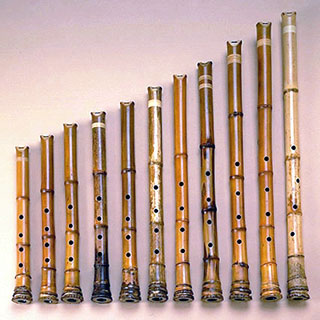|
The
Shakuhachi - Zen Flute

- Zen Flute's in photo by -
Monty H. Levenson
Tai Hei Shakuhachi Flutes
monty@shakuhachi.com
www.shakuhachi.com
The Shakuhachi, or Zen flute, is the traditional Japanese bamboo
flute. In the hands of a master, it produces the most extraordinary,
subtle, sensual music - prized as being almost perfect for relaxation
and meditation.
Any way you look at it, the shakuhachi or Zen flute is an extraordinary
instrument. From the moment of its conception it is extraordinary.
At daybreak in the dead of winter, a Japanese master craftsman
sets out into the frozen bamboo groves in search of the perfect
culm of bamboo. He might rummage through hundreds of acres before
settling on a single stalk of yellow-green bamboo - as tall
as a six storey building, yet with only one small section (typically
55 cm long) suitable for his instrument. Then, applying a combination
of experience, intuition and a little good luck, he begins to
craft his masterpiece ...
The Zen flute is possibly the simplest non-percussive instrument
ever conceived. It has no keys or pads like a western flute,
no reed like a clarinet or saxophone, no strings like a guitar
or violin, no mechanisms inside like a piano or organ; it doesn't
even have a mouthpiece like the recorder. It simply has five
finger holes - fewer than the penny whistle or almost any other
wind instrument - and one end cut to form an angled blowing
edge. Despite this simple construction, the Zen flute (in the
hands of a master musician) can produce an inconceivably broad
range of musical sounds - from pure, flute-like notes, to tones
that are every bit as complex and expressive as the human voice.
Being able to produce such complex and expressive music - as
haunting and as enchanting as you will ever hear - from an instrument
so basic.
The Zen flute came to Japan from China some time in the 8th
century. At that time, the shakuhachi was constructed from the
middle section of a bamboo culm. Around the 15th century in
Japan, the instrument was adopted by a sect of Zen Buddhist
monks - all of whom were samurai - as a tool of meditation.
(They knew that the playing of it relaxed both mind and body,
aiding their spiritual pursuits.)
It was during this period that the Zen flute began to be constructed
from the spiked root section of the bamboo - as it is today
- so the instrument could double as a particularly ferocious
weapon. This probably explains the Zen flute's long association
with the martial arts.
History's most revered instrument of peace and tranquillity
once doubled as a weapon for samurai monks.
Unlike with other instruments, there are no child prodigies
in the shakuhachi tradition. Not one. This is understandable,
since the instrument is not only immensely difficult to excite,
but also takes many years of dedicated training to attain a
standard where you would perform.
The Zen flute is not like a recorder: it has no mouthpiece
as such, and simply blowing in one end will not produce a sound.
To play a note, your lips and mouth must become part of the
instrument (how appropriate for an instrument known as the
Zen
flute!). And it is this "oneness" of instrument and
player that permits so much flexibility in pitch, tone, colour,
and loudness of playing.
Part of the discipline of mastering the Zen flute is learning
to deal with the frustrations inherent in learning to play
it.
That is why much of its study is dedicated to "forging
the mind-body" - developing the intuitive, spiritual side
of the performer as much as the musicianship itself. Playing
the shakuhachi in this context is called suizen, or "blowing
Zen". To blow Zen, one requires great breath control; yet,
after years of training and practice, the shakuhachi player
strives not to try to control the breath at all. Instead the
breath is observed. The player "watches" the breath
with a concentration that consumes both the observer and that
which is being observed - the player "becomes" the
breathing.
|